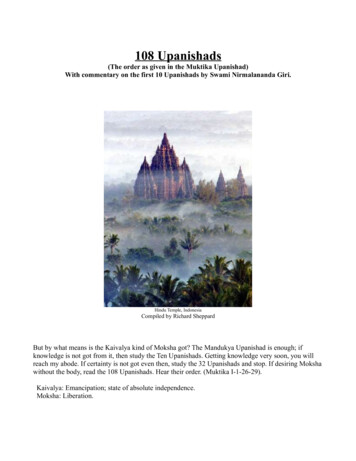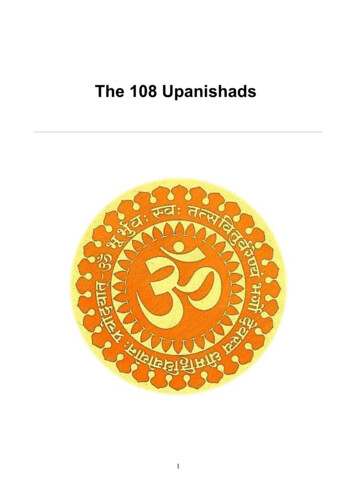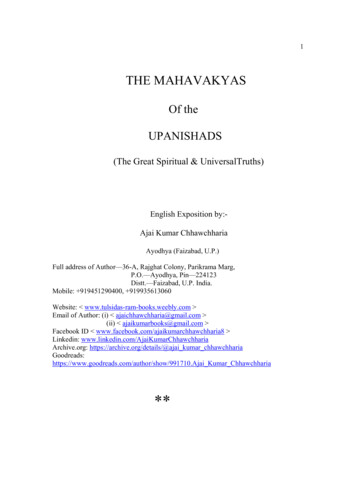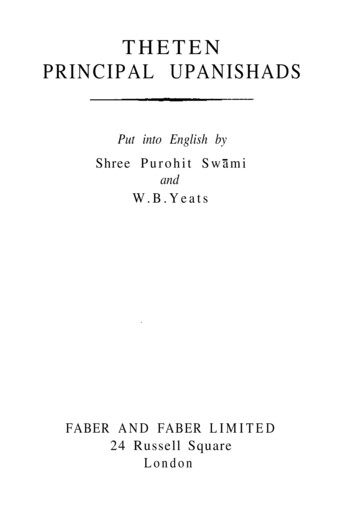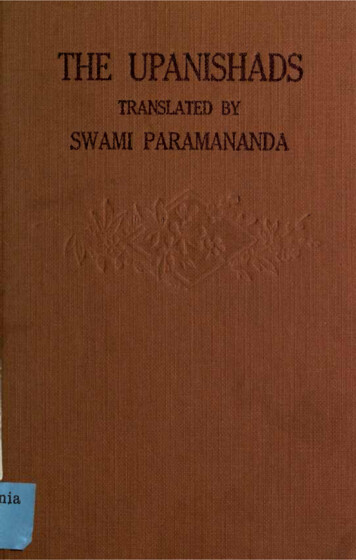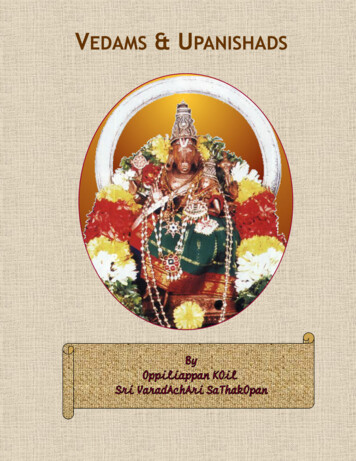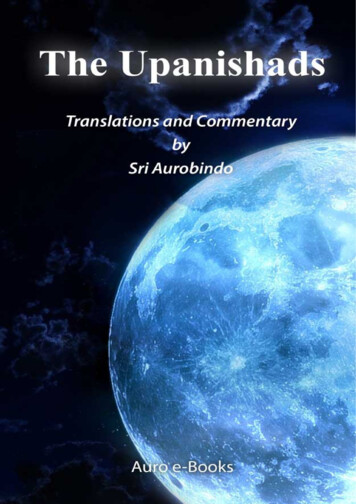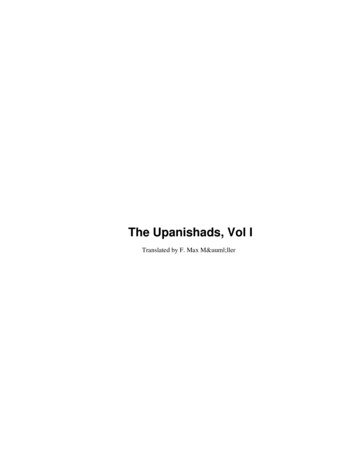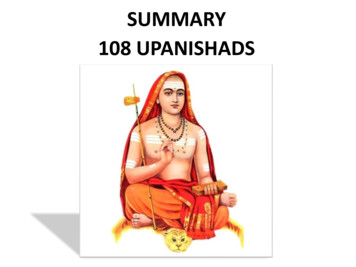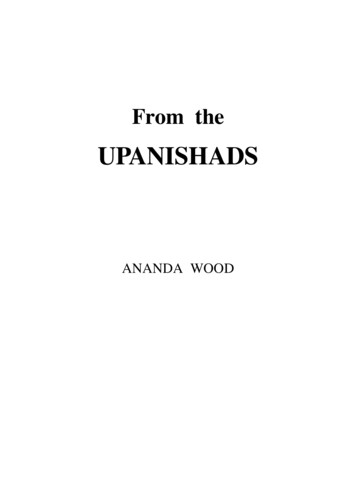
Transcription
From theUPANISHADSANANDA WOOD
Modified version 2000Copyright 1996 by Ananda WoodPrepared by:Ananda Wood1A Ashoka3 Naylor RoadPune 411 001IndiaPhone (020) 612 0737Email awood@vsnl.com
ContentsPreface.viiFrom the Aitareya UpanishadSelf-questioning . . . . . . . . . . . . . . . . . . . . . .Realization . . . . . . . . . . . . . . . . . . . . . . . . . .Consciousness . . . . . . . . . . . . . . . . . . . . . . . .123From the Katha UpanishadDeath and ‘the unconscious’ . . . . . . . . . . . .Self-discovery . . . . . . . . . . . . . . . . . . . . . . . .Desire and enquiry . . . . . . . . . . . . . . . . . . . .Perception . . . . . . . . . . . . . . . . . . . . . . . . . . .Difference . . . . . . . . . . . . . . . . . . . . . . . . . . .Dissipation and purity.The living self . . . . . . . . . . . . . . . . . . . . . . . .The principle of individuality . . . . . . . . . . . .Living energy . . . . . . . . . . . . . . . . . . . . . . . .Self-purification . . . . . . . . . . . . . . . . . . . . . .Meditation . . . . . . . . . . . . . . . . . . . . . . . . . . .Understanding truth . . . . . . . . . . . . . . . . . . .The ‘I’-principle . . . . . . . . . . . . . . . . . . . . . .5252626272728303435383940From the Brihadaranyaka UpanishadNon-duality . . . . . . . . . . . . . . . . . . . . . . . . . .Prayer for truth . . . . . . . . . . . . . . . . . . . . . . .Self and the absolute . . . . . . . . . . . . . . . . . . .The source of experience . . . . . . . . . . . . . . .Mind, speech and life . . . . . . . . . . . . . . . . . .Names, forms and acts . . . . . . . . . . . . . . . . .Cosmic faith and truth.Immanent and transcendent . . . . . . . . . . . . .Self and reality . . . . . . . . . . . . . . . . . . . . . . .A contest of learning.Light . . . . . . . . . . . . . . . . . . . . . . . . . . . . . . .A last settlement . . . . . . . . . . . . . . . . . . . . . .The essence of personality . . . . . . . . . . . . . .41424350525859646567809297
ivContentsFrom the Chandogya UpanishadChange and space . . . . . . . . . . . . . . . . . . . . .Personality and consciousness . . . . . . . . . . .The principle of light . . . . . . . . . . . . . . . . . .Reality and self . . . . . . . . . . . . . . . . . . . . . . .Sacrifice . . . . . . . . . . . . . . . . . . . . . . . . . . . .Subjective and objective . . . . . . . . . . . . . . . .The self in everyone . . . . . . . . . . . . . . . . . . .Where knowledge comes from . . . . . . . . . . .Learning and knowledge . . . . . . . . . . . . . . .Change and self.In search of self.9899100101103104105107112116121From the Kena UpanishadThe unmoved mover . . . . . . . . . . . . . . . . . . .Desire’s end.130134From the Kaushitaki UpanishadFor and against . . . . . . . . . . . . . . . . . . . . . . .Each being’s self . . . . . . . . . . . . . . . . . . . . . .The basis of mind . . . . . . . . . . . . . . . . . . . . .The living principle.Continuing truth . . . . . . . . . . . . . . . . . . . . . .The knowing self . . . . . . . . . . . . . . . . . . . . .Deep sleep and waking . . . . . . . . . . . . . . . . .135136137138140142153From the Isha UpanishadCentre and source . . . . . . . . . . . . . . . . . . . . .156From the Prashna UpanishadMatter and life.Living faculties . . . . . . . . . . . . . . . . . . . . . . .Learning from experience.What lives in sleep? . . . . . . . . . . . . . . . . . . .Contemplation and its results . . . . . . . . . . . .Human existence . . . . . . . . . . . . . . . . . . . . . .162163165168172175
ContentsvFrom the Mundaka UpanishadKnowing and being.Complete knowledge . . . . . . . . . . . . . . .Good acts . . . . . . . . . . . . . . . . . . . . . . . .The unborn source . . . . . . . . . . . . . . . . .The unmoved centre . . . . . . . . . . . . . . .Ego, self and truth . . . . . . . . . . . . . . . . .Attainment to the impersonal . . . . . . . .177177181183185188191From the Mandukya UpanishadThe word ‘Om’ . . . . . . . . . . . . . . . . . . . . . . .195From the Taittiriya UpanishadComplete reality . . . . . . . . . . . . . . . . . . . . . .Levels of appearance . . . . . . . . . . . . . . . . . .Nothingness.The creator . . . . . . . . . . . . . . . . . . . . . . . . . .Kinds of happiness . . . . . . . . . . . . . . . . . . . .Non-dual consciousness . . . . . . . . . . . . . . . .Asking for truth.Sustenance.200204209212217219221225From the Shvetashvatara UpanishadUnderlying Cause . . . . . . . . . . . . . . . . . . . . .Subtle powers . . . . . . . . . . . . . . . . . . . . . . . .Mental discipline.Ego and self.The universal ‘Lord’ . . . . . . . . . . . . . . . . . . .The unborn . . . . . . . . . . . . . . . . . . . . . . . . . .Universal and individual.Immanent and transcendent . . . . . . . . . . . . .226232233234236242248253From the Rig VedaCreation . . . . . . . . . . . . . . . . . . . . . . . . . . . . .261Index267.
PrefaceDo we know anything that is plainly and simply true, without any of the ‘ifs’and ‘buts’ that complicate everything we perceive through our limited anduncertain personalities?And is it thus possible to find any common basis of knowledge on whichwe can always rely, no matter what particular conditions and uncertaintiessurround our little bodies, senses and minds in a much larger universe?The Upanishads are early texts that describe just such an enquiry into plaintruth. However, there are two problems which complicate our understandingof these texts today.First, they were composed at a time when knowledge was largely expressedin the imaginative metaphors of myth and ritual. Thus, along with their philosophical enquiry, the Upanishads also describe an archaic mythical and ritualcontext. It is from this archaic context that the enquiry was made, in timesthat are now long passed.And second, as the founding texts of a very old philosophical tradition,they are expressed in a highly condensed way: which leaves them ratheropen to interpretation and explanation. The condensed statements of theUpanishads were called ‘shruti’ or ‘heard’; because they were meant to belearned by hearing them directly from a living teacher, who would recite andinterpret the words. Having received such a statement of condensed philosophical teaching, a student was meant to think about it over and over again,through a sustained process of individual reflection and enquiry. Eventually,after passing through many stages of thinking and rethinking the questionsinvolved, the student was meant to come at last to a thorough and independent understanding of the statement, in his or her own right.In the two and a half thousand years or more since the Upanishads beganto be composed, their original statements have been interpreted and explainedin many different ways, through many different schools of thought. Someschools have emphasized a religious approach to truth, through devotion to aworshipped God. Some schools have emphasized a mystical approach, throughexercises of meditation that cultivate special states of experience beyond theordinary limitations of our minds. And some schools emphasize a philosophical approach, through reasoned enquiry into common experience.
viiiPrefaceThis book is focused on the philosophical approach. It follows Shri Shankara’s Advaita Vedanta tradition, as interpreted by Shri Atmananda, a modernadvaita philosopher who lived in Kerala State, India, 1883-1959.The book is a collection of retellings from selected passages of the Upanishads. In these retellings, the rather compressed ideas of the original textshave been freely interpreted and elaborated, and often modified, to makethem more accessible to a modern reader. Naturally, there is a price to be paidfor such interpretation and modification. Since traditional ideas have thusbeen freely expressed in modern terms, the reader should understand that theretellings differ somewhat in their manner of expression from the traditionalapproach that is found in the originals.For those who are interested in the original texts, a companion volume,called Interpreting the Upanishads, shows how particular concepts and passages have been interpreted in the retellings. For each passage discussed inthe companion volume, a cross reference is given in a footnote at the beginning of the relevant retelling.Hence this book and its companion volume form a pair, with cross-references between them. However, each volume can be read quite independentlyof the other.Like the original texts, the book is perhaps best read as an anthology ofcollected passages. Because of their condensed expression, the Upanishadsare meant to be thought about selectively, concentrating attention on onepassage at a time. In various different passages, the same fundamental principles are approached again and again, in various different ways. Thus, oneis free to pick out a particular passage that suits one’s interests and one’s stateof mind at the time.The trick is to avoid confusing the differing approaches through which theUpanishads ask different questions about one common truth. Then one canconcentrate on those particular passages and those particular questions thathold one’s attention sufficiently for the hard thinking that the subject requires.
From the Aitareya UpanishadSelf-questioningWithout me here, to know experience,how could this experience be?And how do I continue on?If it’s by speech that words are said,if odours are perceived by smell if sights are seen by sense of vision,sounds are heard by sense of hearing,feelings felt by sense of touch,and thoughts conceived by changing mind if thoughts and sense-perceptions areabsorbed within by understanding,and appearances are formedby mind’s expressive thoughts and acts then who, or what, am I?from1.3.11
2AitareyaRealizationThat which was born sees many things;but what is here that’s alien?What does one really want to say?By asking questions in this way,the principle we each call ‘I’and absolute reality,pervading all experience,are realized as: ‘This alonethat, truly, I have always known.’from1.3.13
Aitareya3Consciousness 1What is this selfto which we pay such heed?Is it that which seesor hears or sensesour perceptionsof the world?Does it speak?Does it tell tastefrom tastelessness?from3.1.1Or is it mind and heart:which we describe as wisdom,judgement, reason, knowledge,learning, vision, constancy,thought, consideration, motive,memory, imagination, purpose,life, desire, vitality?These are but namesfor consciousness.from3.1.2Consciousness is everything:God, all the gods,the elements of which the world is made,creatures and things of every kind,however large or small,however born or formed,including all that breathes, walks, flies,and all that moves or does not move.All these are known by consciousness,and take their stand in consciousness.1See Interpretingthe Upanishads, pages 6-10, for an indication of how this retellinginterprets the original text.
4AitareyaComing after consciousness,the whole world stands in consciousness.Consciousness is all there is.from3.1.3One who knows self,as consciousness,has risen fromthis seeming worldto simple truth:where all desiresare attainedand deathlessnessis realized.from3.1.4
From the Katha UpanishadDeath and ‘the unconscious’ 1Naciketas was a young Brahmin, blessed with a bright and cheerful temperament. But, on occasion, he was given to moods of intense thought. Duringone of these moods, when he was still a child, he had been asked what he wasthinking about. He had some difficulty replying, but after a while he said:‘I don’t quite know. That’s what I keep trying to find out. But the harder Itry, the less I seem to know. In the end, it seems that my mind knows nothingat all.’It was this answer that earned him the name ‘Naciketas’, which means ‘theunconscious’.When Naciketas was on the verge of manhood, his father had become tiredof material possessions and wished for better things. So a great sacrifice washeld, to give all worldly wealth away.As the family’s cattle were being taken away, Naciketas felt greatly disturbed. He thought:‘These cattle need water to drink and fodder to eat. They need to be milked.And they aren’t quite able to look after themselves. Surely it’s we who shouldbe looking after them, and the rest of our family inheritance. Will it reallybring us happiness to give up our responsibilities like this? Perhaps fatherwants no further responsibility for me either.’So Naciketas went up to his father and asked quietly: ‘Father, to whomwill you give me?’Naciketas’s father was busy with the well-wishers and admirers who surrounded him, and the question went unanswered. So Naciketas repeated it, alittle louder. But now, as it became apparent that Naciketas was insisting onsaying something out of place, an awkward silence followed. In this silence,Naciketas repeated his question a third time, with the most embarrassingclarity.In a fit of anger, his father replied: ‘So, young man, your ego has got the1SeeInterpreting the Upanishads, pages 152-153, 197-198 and 138-141, for an indication of how parts of this retelling interpret the original text (in particular: 2.1-2,2.7-9 and 3.1,3-4, respectively).
6Kathabetter of you. There is only one thing to do with such an inflated ego. Go giveit to death, where it belongs.’At this, Naciketas turned round and walked away. He walked on for manyhours, paying little attention to where he was going. Instead, he kept tryingto make sense of his father’s enraged pronouncement, and how to act in accordance with it:‘This little self that feels so youngnow goes to death before its time,ahead of those it knows and loves. ‘But it is
Upanishads were called ‘shruti’ or ‘heard’; because they were meant to be learned by hearing them directly from a living teacher, who would recite and interpret the words. Having received such a statement of condensed philo-sophical teaching, a student was meant to think about it over and over again, through a sustained process of individual reflection and enquiry. Eventually, after .
